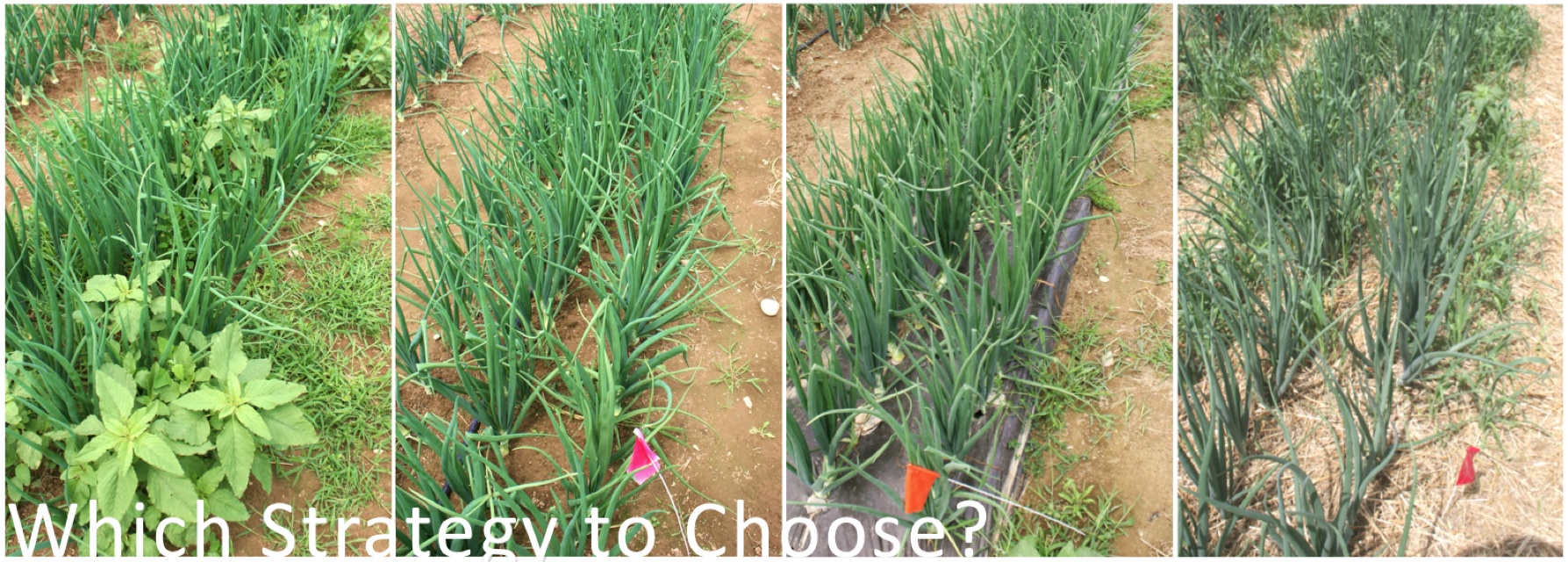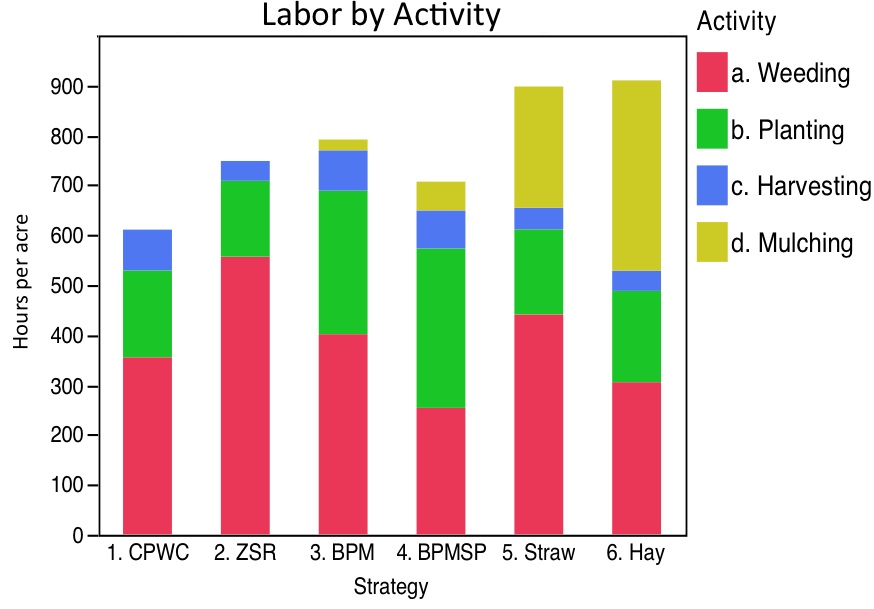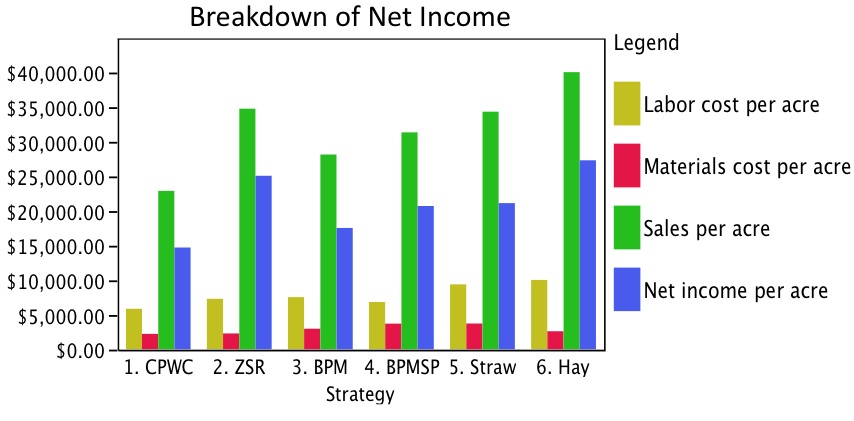A Comparison of Organic Weed Management Strategies in Onions
Bryan Brown, Ph.D. Student, and Eric Gallandt, Associate Professor
What’s your strategy for managing weeds? Cultivate until the crop is large enough to tolerate late-emerging weeds, sometimes returning to harvest from a dense patch of weeds? Cultivate season long and pull any mature weeds as part of a longer-term strategy to prevent weed seed rain and make weeding easier and less costly over time? Intensively mulch to prevent weeds, perhaps improve soil quality, and reduce labor demands for weeding later in the season?
There are successful organic farmers who rely on each of these strategies, some using different strategies for different crops, others with a singular focus. Clearly there is no “best” strategy, but rather, trade-offs and compromises associated with each. Our aim with this field study comparing weed management systems is to quantify multiple dimensions of each system so farmers can evaluate and choose a strategy that is best aligned with their own philosophy, priorities and infrastructure constraints.

Using yellow storage onions as our test crop (planted with two onions per hole, spaced 6” apart within rows and 3 rows per bed) on a field with a moderate weed seedbank at the University of Maine Rogers Farm, we implemented several prominent strategies:
1) Critical Period Weed Control (CPWC) – Control weeds only during the crop’s sensitive adolescent stage. This is the minimum amount of weeding you can do and still get a viable crop. However, it allows late-season weeds to go to seed.
2) Zero Seed Rain (ZSR) – Frequent cultivation with the goal of not letting any weeds set seed so that none “rain” to the ground. A strategy expected to be initially costly, but with decreasing cost over time as weed pressure declines.
3) Black Plastic Mulch (BPM) – Suppresses weeds and warms soil. Requires cultivation for the paths.
4) Black Plastic Mulch with Straw-Mulched Paths (BPMSP) – Suppresses weeds in the path as well; added organic matter in the paths.
5) Straw Mulch – Suppresses weeds and adds organic matter to the soil. Applied by hand in June after soil has warmed and onions are approximately the diameter of a pencil.
6) Junk Hay Mulch – Similar to straw but less expensive.
Aside from primary and secondary tillage and application of plastic mulch, all activities were done by hand. Cultivation was achieved by wheel hoeing the paths, scuffle hoeing the shoulders and between rows, and using short-handled hoes for within rows. Drip irrigation was used to keep soil moisture levels optimum for each plot.

Labor by Activity from our 2014 field season (above) demonstrates that CPWC plots required the least amount of labor. Although they were weeded clean through early July, by the end of the season these plots were a weedy mess, and resultantly, had the longest harvest times. In the spring of 2015 we will collect soil samples to see how much weed seed was added to the seedbank.
In ZSR plots, weeding events took place about every ten days in the early- and mid-season, depending on weather, and less often later in the season as weed germination slowed.
Plastic-mulched plots required three hand-weedings to control the crabgrass coming through the planting holes, suggesting that plastic might be better suited to crops with wider spacing. Also, transplanting by hand took longer in plastic mulch. Soil temperatures under the black plastic were consistently 5-10 degrees Fahrenheit higher than the others. Onions under black plastic matured several weeks earlier, which may have contributed to the decreased yield. The BPMSP required the lowest amount of weeding labor of all strategies.
We used high quality oat straw mulch that didn’t have any weed seed but it did bring in a lot of oat seed (112 seeds/lb) that germinated within the mulch and forced us to hand pull twice. The straw mulch was much easier to apply than the junk hay, which stuck together. The junk hay mulch brought in a lot of weed seed (170 seeds/lb) but few weeds emerged through the mulch.
Not surprisingly, at the end of the season, mulched plots had less compacted soil and better water infiltration than unmulched plots. Plots with organic mulch had more earthworms than the others.
After harvest, the onions were cured in a greenhouse and weighed to measure marketable yield. Insect damage and disease were minimal for all strategies.

In the Breakdown of Net Income (above), labor costs were set at $10/hour. Materials costs included fertility, mulches, tractor use, and an estimate of curing, packing, and shipping costs. Sales were calculated by assuming that 90% of the cured marketable yield could be sold at the organic wholesale price of $0.75/lb. Net income was determined as the difference between sales and costs of labor and materials.
It was surprising that the strategies typically used for long-term aims of reducing the weed seedbank (ZSR) or building soil quality (organic mulches), were the most profitable in the first year of implementation. That these more expensive strategies were more profitable than the others demonstrates the importance of high yields.
The CPWC was the lowest yielding strategy, indicating that the weed control period was not long enough. Based on growing-degree-days we expect that the onions should have been weeded through late July to avoid yield loss. This highlights the sensitivity of onions to competition.
In 2015, soil samples will be collected to determine the effects of the contrasting weed management strategies on the weed seedbank and soil organic matter. The onion experiment will also be repeated on a new field to show which results are consistent and which results are subject to yearly variation, so stay tuned for this season’s results!
